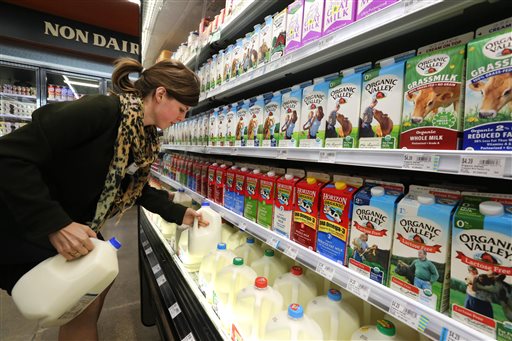Dairy industry braces for a milk bust following 2014 boom

After a record year for milk sales in 2014, dairy farmers face a glut. Already disheartened, farmers say they worry as futures markets predict dwindling prices in 2015. But in the dairy aisle shoppers are milking savings.
MADISON, Wis. >> Milk sales set records in 2014, but plummeting prices are forcing some dairy farmers to spill the surplus down the drain.
Already disheartened by the current glut, which is due to global factors and overproduction, dairy farmers say they worry that futures markets predict dwindling prices in 2015. Over in the dairy aisle, though, shoppers are milking savings by the gallon.
“I guess I’m sorry if I’m hurting the farmer or the middleman, but I’m certainly delighted to pay under $3 a gallon,” said Michael Kleinhenz, of Madison, Wisconsin.
Dairy farmers recognize the volatility of the industry. Less than a year ago, they struggled to meet global demand and milk prices climbed to record highs — about $25 per hundredweight, or roughly the equivalent of a 10-gallon tank, according to Mark Stephenson, director of dairy policy analysis at the University of Wisconsin.
So, many farmers bought new equipment and expanded their herds to meet demand. But when China pulled back on its dairy imports after stockpiling milk powder and Russia imposed sanctions against the U.S. by halting trade, dairy farmers nationwide were left with a surplus, Stephenson said.
“We were told to bring everything to a screeching halt,” said Norbert Hardtke, director of milk marketing at Family First Dairy Cooperative in Madison, Wisconsin.
Don't miss out on what's happening!
Stay in touch with breaking news, as it happens, conveniently in your email inbox. It's FREE!
Every state has some dairy production, but California and Wisconsin anchor the country’s supply. The milk glut reached its peak in the Northeast over the holidays, when cooperatives asked farms to pour out some of their milk.
“It’s something that no farmer likes to do … it doesn’t feel good to just dump it out,” New York-based Northeast Dairy Producers Association board director Jon Greenwood said.
And with an excess of milk in the international market, prices for milk, butter and milk powder continue to drop. Market predictions for 2015 look worse, Hardtke said, as prices are expected to drop through the spring — about $13.50 per hundredweight in March. Dairy Farmers of America, a national marketing cooperative, has started charging its 15,000 members 50 cents per hundredweight to account for additional transportation fees and low prices.
Many dairy farmers recall 2009 with dread, when prices plunged and some were forced to sell off cows. Hardtke said the years since have been a roller coaster.
If prices continue to dwindle, Wisconsin dairy farmer Rick Steger says his income will decrease by a third — if not more.
“I’m very worried because it’s such an extreme drop,” said Steger, whose farm is in Theresa, 50 miles northwest of Milwaukee. “Our expenses aren’t going to drop.”
Steger said he signed up for the Federal Margin Protection Program last year, but he believes it would not cushion the blows expected this year.
The U.S. Department of Agriculture program, a product of the 2014 Farm Bill, serves as a sort of insurance policy for farmers. The program sets average national feed prices, and farmers subtract that price from their milk price to determine their margin; if the margin is below a pre-determined amount, farmers get money from the USDA. More than half of the nation’s dairy farmers enrolled in the program before the December deadline, the USDA said recently.
The boom-and-bust cycle is just part of the business, said Greenwood, who farms in Canton, New York, and didn’t enroll in the federal program. He said feed prices are low, “so things are not as bad as they could be.”
Meanwhile, consumers are seeing milk prices slashed. At the peak last year, a gallon of whole milk cost an average of $3.86. The most recent numbers from the Bureau of Labor Statistics indicate it’s now $3.82 a gallon — lower in places like Madison, where skim milk cost $2.99 a gallon– and prices are again expected to fall this spring.
Madison mom Angela Willard said she was happy about the lower prices because her two children “drink milk like no other.”
Her 8-year-old daughter Alexandria added, “It will be gone in like two days.”
Such milk-drinking families could play a role in leveling out demand “dramatically” by buying more dairy, Hardtke said.
“We just need people in the US to buy more milk,” Hardtke said. “That would really help us out.”





